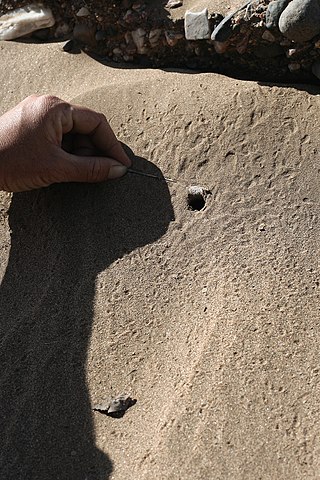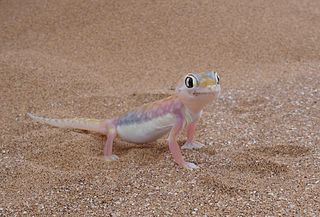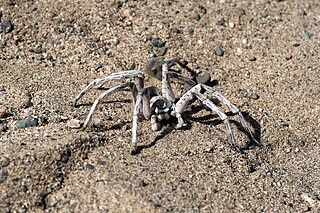
The Namib is a coastal desert in Southern Africa. According to the broadest definition, the Namib stretches for more than 2,000 kilometres (1,200 mi) along the Atlantic coasts of Angola, Namibia, and northwest South Africa, extending southward from the Carunjamba River in Angola, through Namibia and to the Olifants River in Western Cape, South Africa. The Namib's northernmost portion, which extends 450 kilometres (280 mi) from the Angola-Namibia border, is known as Moçâmedes Desert, while its southern portion approaches the neighboring Kalahari Desert. From the Atlantic coast eastward, the Namib gradually ascends in elevation, reaching up to 200 kilometres (120 mi) inland to the foot of the Great Escarpment. Annual precipitation ranges from 2 millimetres (0.079 in) in the aridest regions to 200 millimetres (7.9 in) at the escarpment, making the Namib the only true desert in southern Africa. Having endured arid or semi-arid conditions for roughly 55–80 million years, the Namib may be the oldest desert in the world and contains some of the world's driest regions, with only western South America's Atacama Desert to challenge it for age and aridity benchmarks.

Huntsman spiders, members of the family Sparassidae, are known by this name because of their speed and mode of hunting. They are also called giant crab spiders because of their size and appearance. Larger species sometimes are referred to as wood spiders, because of their preference for woody places. In southern Africa the genus Palystes are known as rain spiders or lizard-eating spiders. Commonly, they are confused with baboon spiders from the Mygalomorphae infraorder, which are not closely related.

Ptenopus is a small genus of lizards, known commonly as barking geckos, in the family Gekkonidae. The genus is endemic to southern Africa. There are only three described species in this genus.

Leucorchestris arenicola, commonly called the dancing white lady spider, is a huntsman spider in the family Sparassidae and genus Leucorchestris. It is commonly found in the Namib desert of Namibia. It is often mistaken with the similarly named Carparachne aureoflava, or more commonly known as the wheel spider from the same location. L. arenicola relies on seismic vibrations, called drumming, for communication. It taps its foremost legs on the sand to send messages to other white lady spiders. Male L. arenicola will travel over 50 m in one night searching for a mate. If they find a mate, they must be extremely careful, for drumming the wrong message can be deadly. One of the major features that characterizes its nocturnal behavior is its specialized vision, using eight eyes in different orientations to capture a panoramic view of the surroundings. L. arenicola spiders use temporal summation in order to be able to see dim lighting during night-time wanderings. The species was first described by Reginald Frederick Lawrence in 1962, who described all the species in the genus Leucorchestris.

The Namaqua chameleon is a ground-living lizard found in the western desert regions of Namibia, South Africa and southern Angola.

The gemsbok, or South African oryx, is a large antelope in the genus Oryx. It is endemic to the dry and barren regions of Botswana, Namibia, South Africa and Zimbabwe, mainly inhabiting the Kalahari and Namib Deserts, areas in which it is supremely adapted for survival. Previously, some sources classified the related East African oryx, or beisa oryx, as a subspecies.
A White Lady is a type of female ghost, typically dressed in a white dress or similar garment.

The scrub hare is one of two species of hares found in southern Namibia, Mozambique, South Africa, Eswatini and Lesotho. Although it is listed as a least concern species, the population has been declining and is expected to decline by 20% over the next 100 years.
The Namib brush-tailed gerbil or Setzer's hairy-footed gerbil is a species of rodent endemic to Angola and Namibia. Its natural habitats are sandy and gravelly plains. It stays in its burrow by day, emerging at night to feed on arthropods, vegetable matter, and seeds.

The desert rain frog, web-footed rain frog, or Boulenger's short-headed frog is a species of frog in the family Brevicipitidae. It is found in Namibia and South Africa. Its natural habitat is the narrow strip of sandy shores between the sea and the sand dunes. It is threatened by habitat loss by such factors as mining and tourism.

The wheel spider or golden wheel spider, is a huntsman spider native to the Namib Desert of Southern Africa. This spider is distinct from Leucorchestris arenicola, a spider sharing the same common name and found in the same locale. The spider escapes parasitic pompilid wasps by flipping onto its side and cartwheeling down sand dunes at speeds of up to 44 turns per second.
Carparachne is a genus of Namibian huntsman spiders that was first described by R. F. Lawrence in 1962. As of September 2019 it contains two species, found in Namibia: C. alba and C. aureoflava. The golden wheel spider uses cartwheeling to move across hot, sandy ground, similar to the related Cebrennus rechenbergi, which uses a flic-flac motion.

Pachydactylus rangei, the Namib sand gecko or Namib web-footed gecko, is a species of small lizard in the family Gekkonidae. It inhabits the arid areas of Angola, Namibia, and South Africa, and was first described in 1908 by Swedish zoologist Lars Gabriel Andersson, who named it after its finder, German geologist Dr. Paul Range.

Cebrennus rechenbergi, also known as the Moroccan flic-flac spider and cartwheeling spider, is a species of huntsman spider indigenous to the sand dunes of the Erg Chebbi desert in Morocco. If provoked or threatened it can escape by doubling its normal walking speed using forward or backward flips similar to acrobatic flic-flac movements used by gymnasts. C. rechenbergi is the only spider known to use this unique form of rolling locomotion. The discovery of the Moroccan flic-flac spider has influenced biomimetic robot research, resulting in the development of an experimental robot based on the spider's motion.
Toktokkies are various species of beetles that belong to the large Tenebrionidae family, also known as Darkling beetle. Toktokkies do not belong to a particular tribe or genus of Tenebrionids, but rather a selection of flightless species that make distinct noises by tapping on the ground with the abdomen. The Tenebrionidae family to which these beetles belong is quite large, with almost 3,500 species inhabiting Southern Africa. Nearly 200 species of Toktokkies inhabit the Namibia and 20 have adapted to the extreme temperatures of the Namib Desert. The most common Toktokkies in the Namib Desert are the Fog Basking beetle and the button beetle or trench-digging beetle.

Seothyra, commonly known as the buckspoor spiders, buck spoor spiders or just spoor spiders, belong to a sand-dwelling, burrowing genus of araneomorph spiders in the family Eresidae. The 13 species are endemic to the arid, sandy flats and semistabilized red dunes of southern Africa. They are sexually dimorphic. The tiny males, which are seldom seen, imitate sugar ants or velvet ants in their appearance and habits, while the females hide in and hunt from their characteristic burrows. They are thermophilous, with males as well as females being most active on hot days.

The Angolan giraffe, also known as the Namibian giraffe or smokey giraffe, is a species or subspecies of giraffe that is found in northern Namibia, south-western Zambia, Botswana, western Zimbabwe and since mid-2023 again in Angola.
Microrchestris is a genus of Namibian huntsman spiders that was first described by R. F. Lawrence in 1962. As of September 2019 it contains two species, found in Namibia: M. melanogaster and M. scutatus.

Orchestrella is a genus of Namibian huntsman spiders that was first described by R. F. Lawrence in 1965. As of September 2019 it contains two species, found in Namibia: O. caroli and O. longipes.

Stegodyphus dumicola, commonly known as the African social spider, is a species of spider of the family Eresidae, or the velvet spider family. It is native to Central and southern Africa. This spider is one of three Stegodyphus spiders that lives a social lifestyle. This spider has been studied living in large natal colonies in large, unkempt webs. Each colony is composed mainly of females, where a minority act as reproducers, and a majority remain childless and take care of the young. Males live a shorter lifespan, during which they will largely remain in the natal nest. Females are known for extreme allomaternal care, since all females – even unmated virgin ones – will take care of the young until they are eventually consumed by the brood.















